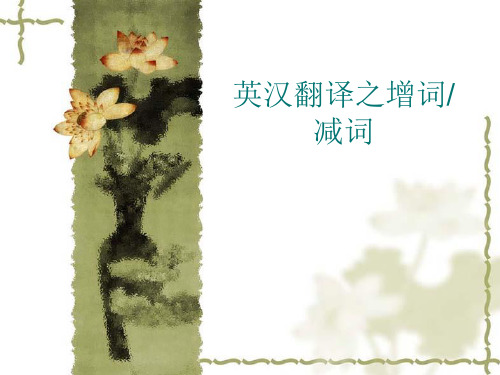翻译(1)减词
- 格式:docx
- 大小:18.20 KB
- 文档页数:3






考研英语翻译7大技巧考研英语翻译7大技巧一、增译主语由于表达习惯不同,英文中常有省略主语的现象,在翻译成汉语时要把它们译出来。
情况一般有以下几种:以抽象名词作主语,而中文的表达习惯则需要把抽象变为具体;英文中常常会为了避免重复而多用介词,中文则不怕重复,一个词会用上好几遍;英语中的复数名词译为汉语时,常常加入这些、各种、种种等,要视具体语境情况而定。
He did not give us satisfied answer; this made us angry.他并没有给出我们满意的答复,这种态度使得我们非常生气。
There are solutions proposed to solve the public problem.针对这一公共问题,大家提出了种种解决方案。
二、增译谓语同理,需要增译谓语的情况也时有出现。
英语中出现两个或多个相同谓语时,常常会省略,以使句子不那么赘余,而中文中则要译出来,使其表达更加地道。
英文中的介词短语译为中文时往往要增译动词,而有些英语中的名词在译为中文时也要加入相应的动词,使其意义更加完整,表达更加明确。
We went to Xiamen this week, Shenzhen next week.我们这周去厦门,下周去深圳。
After the party, he has got a very important speech.参加完聚会后,他还要发表一个重要讲话。
三、时间状语的翻译1、时间状语常常可以直接翻译,一般译到主句前。
He came in while I was watching TV.我在吃饭的时候他进来了。
They burst into tears suddenly when they heard the sad news.他们听到这个悲惨的消息之后突然大哭起来。
2、有的时间状语从句引导词除了表示时间以外,还会附带条件性,所以在翻译的时候要译出条件关系。
大学英语六级考试翻译技巧(5个)1.增词有时为了能充分表达中文的含义,有必要增加词语来使英文的表达更加具体。
例如:新冠肺炎可具体以通过人的手传染。
译文为:COVID-19can be spread by hand contact.contact(接触)就是根据译文需要添加的。
2.减词有时,中文里的一些词没有实际含义,翻译时可以适当删去,让译文更简单。
比如:政府十分重视环境保护的问题。
The government attaches great importance to environmental protection.“的问题”属于多余的成分,指的就是环境保护,因此可以减词,不用翻译“的问题”。
3.词性转换词性转换的技巧在汉译英中十分常用,比如动词转名词,动词转介词。
例如:各国必须同心协力,构筑一个和平的世界。
译文:All countries must work together for a peaceful world.中文的动词“构筑”转换为了介词for。
4.切换主语汉译英时,名词原则上都可以做主语。
因此,直译不通时可以选择切换主语。
比如:过去40年,中国发生了天翻地覆的变化。
译文:In the past forty years,great changes have taken place in China.这句话也可以用中国或过去40年做主语:--In the past forty years,China has seen great changes.--The past forty years have seen great changes in China.5.分译与合译中文经常会出现很长一句话,全部用逗号连接的情况,翻译的时候可以适当按照意群分开翻译。
比如:中国目前拥有世界上最大最快的高速铁路网,高铁列车的运行速度还将继续提升,更多的城市将修建高铁站。
这句话就可以分开翻译:China now has the largest and fastest high-speed railway network in the world.The speed of high-speed trains will go on to be improved.More and more cities are building their high-speed railway stations.(原文中三个逗号,译文分开翻译了)同时,两个较简短的汉语句子也可以合译成一句英文,用连接词来衔接。
四级翻译技巧——增词法在翻译段落时,为了能充分的表达原文含义,以求达意,翻译时有必要增加词语来使英文的表达更加顺畅。
栗子:虚心使人进步,骄傲使人落后。
译文: Modesty helps one to go forward, whereas conceit makes one lag behind.批注:中间加上了增连词wh er ea s,以使英语的句子表达更加有逻辑性。
四级翻译技巧——减词法英语的表达倾向简洁,汉语比较喜欢重复。
重复,作为一种汉语修辞方法,在某种场合下,重复的表达一个意思,是为了强调,加强语气。
为了有更强的节奏感和押韵,汉语中也经常会出现排比句。
考生在翻译这些句子时,为了符合英文表达的逻辑,就要有所删减或省略。
栗子:这是革命的春天,这是人民的春天,这是科学的春天!让我们张开双臂,热烈拥抱这个春天吧!译文:Let us stretch out our arms to embrace the spring, which is one of the r e v o l u t i o n,o f t h e p e o p l e,a n d o f s c i e n c e.批注:如遇到重复的汉语排比句,汉译英时记得遵守英语的逻辑表达,用定语从句来翻译,使英文句子读起来也朗朗上口。
四级翻译技巧——词类转换英语语言的一个很重要的特点,就是词类变形和词性转换,尤其是名词、动词、形容词之间的转换。
栗子:她的书给我们的印象很深。
译文:Her book impressed us deeply.批注:在这里汉语中的名词需转化成英语中的动词"impress"。
四级翻译技巧——语态转换语态分为被动语态和主动语态,汉语中主动语态出现频率较高,而与之相反,英语中被动语态的使用率较高。
因此考生在翻译时,要注意语态之间的转换。
栗子:这个小女孩在上学的路上受了伤。
译文:The little girl was hurt on her way to school.批注:这里,“受了伤”的主动语态转换为"was hurt"的被动语态。
减词是指将原文中需要、而译文中又不需要的词语省去。减省的词语应是那些在译文中保留下来反而使行文累赘噜嗦、且不合汉语语言表达习惯的词语。减词一般用于以下两种情况:一是从语法角度进行减省;二是从修饰角度进行减省。
一、 从语法角度进行减省 英汉两种语言在语法上差异较大,例如:英语有冠词,而汉语却没有;英语重形合、连接词较多,汉语重意合、连接词较少;英语中介词丰富,多达280多个,汉语中介词则较少,只有30来个;英语中经常使用代词,尤其是经常使用人称代词、关系代词等,而汉语中代词则用得较少;因此,英译汉时可根据具体情况将冠词、连接词、介词、代词略去,使译文练达晓畅。例如:
(1) I know my friends from the feel of their faces. 我靠触摸脸庞来辨认朋友。
(2) Ice is a solid. If we heat it, it melts and becomes water. 冰是固体,如果加热,就融化成水。
(3) John got up very early in the morning. He put on his jacket, sat down at his desk and began to do his homework. 约翰早晨起床很早,他穿上夹克,就坐在桌旁开始做家庭作业。
(4) But at the present moment the whole road looked rather pretty, for the sun had just set in splendor, and the equalities of rent were drowned in a saffron afterglow. 但此时整条路看起来都挺美,金灿灿的太阳刚落下山,橙红色的余辉掩盖了房屋的种种差异。
(5) He had a shelf there, where he kept his Bohemian papers and his pipes and tobacco, and his shears and needles and thread and tailor's thimble. 他放在那儿有一个架子,摆着他的波希米亚报纸、烟斗、烟叶,还有大剪刀、针、线,以及裁缝用的顶针。
(6) Most of the people who appear most often and most gloriously in the history books are great conquerors and generals and soldiers… 史书上最经常出现、最为显赫的人物,大多是些伟大的征服者、将军和军事家。
(7) The city has a dense manufacturing population. 这个城市有稠密的工业人口。
(8)The products should be sampled to check their quality before they leave the factory. 产品出厂前应该进行抽样检查。
(9) The mother and the eldest daughter weeded the 该文章转载自无忧考网:http://www.51test.nete ridges, passing before the others…A younger son, of twelve years, brought sea sand in a donkey's creels from a far corner of the field. They mixed the sand with the black clay. The fourth child, still almost an infant, staggered about near his mother, plucking weeds slowly and offering them to his mother as gifts. 母亲和大女儿在除垄上的草,把旁人甩在后面……二儿子十二岁,从老远的地头把海滩上的沙子装进鱼篮,赶着毛驴驮了回来。他们把黑土掺上了沙子。老四还是个小不点儿,在母亲身边遥遥晃晃转悠着,慢吞吞地拔起杂草,当礼物送给母亲。
(10) Come if you like.高兴来就来。 (11) As it is late, let us go to bed.不早啦,睡吧! (12) I framed the words in my mind: "Pardon me, but have I done something to offend you?" 我心里在嘀咕:"对不起,我有什么举止行为冒犯你了吗?"
(13). You hear it from the trackers, a more breathless chant, as they pull desperately against the current, half a dozen of them perhaps if they are, taking up a wupan, a couple of hundred if they are hauling a splendid junk, its square sail set, over a rapid. 纤夫拼命拉纤逆流而上时,你就会听见他们唱着较急促的号子。拉五板木船时,或许五六人就行,但当拉着鼓着横帆的大船过急滩时,那就得要二三百人。
(14). If you are a twinkler, you have the ability to walk into a room and bring the sunshine with you, making everyone else want to bask in it. 满怀喜悦的人能把阳光带进他所走进的房间,使别人愿意沐浴在这阳光中.
二、从修饰角度进行减省 有些词语在英语里是必不可少的,但在汉语中却并非如此,如直译成汉语则往往显得累赘噜嗦。为了使译文简洁晓畅、"文约而意丰",这样的词语必须省去或是精简。例如:
(1) I felt a trifle shy at the thought of presenting myself to a total stranger with the announcement that I was going to sleep under his roof, eat his food and drink his whisky, till another boat cam e in to take me to the port for which I was bound. 我要去见一个素不相识的陌生人,向他宣布我得住在他家、吃他的、喝他的,一直等到下一班船到来,把我带到我要去的港口为止──想到这儿,我真有点不好意思了。(这里,如把 "sleep under his roof, eat his food and drink his whisky"直译为"睡在他的屋顶下、吃他的食物、喝他的威士忌",会使语言极为繁冗,不够精练。译文采用减省译法处理原文,既准确地传达了原意,又使行文简洁,气韵十足,一气呵成。)
(2) Her dark eyes made little reflected stars. She was looking at him as she was always looking at him when he awakened. 她那双乌黑的眼睛就像亮晶晶的星星在闪烁,他平素醒来的时候,她也是这样望着他。(此句中有两个 "she was looking at him",如不作省略而译为"她像平常那样望着她一样望着他",汉语就显得噜嗦繁复,诘屈聱牙。)
(3) University applicants who had worked at a job would receive preference over those who had not. 报考大学的人,有工作经验的优先录取。
(4)There was no snow, the leaves were gone from the trees, the grass was dead. 天未下雪,但叶落草枯。
(5) There was not a sound in her——and around us nothing moved, nothing lived, not a canoe on the water, not a bird in the air, not a cloud in the sky. 船上悄然无声,四周一片静谧,死一般沉寂,水面不见轻舟飘动,天空不见小鸟浮云。
(6) The problem of alternative fuels of vehicle is one problem we shall approach. 车辆的代用燃料是我们将要研究的一个问题。
(7) There are some things that I have happily seen of the wondrous way of the spider. 蜘蛛的奇异动态,我曾有幸目睹。 (译文省去 "there are some things that"后,文字简约,表达生动,意思明确。)
(8) In actual fact, the United States is pursuing a policy of encouraging the aggressor… 实际上,美国在推行一种鼓励侵略者的政策……
(9) He was smooth and agreeable. 他待人处事,八面玲珑。
(10) Standing as it does on a high hill, the church commands a new view. 教堂建在高山上,向下眺望,风景优美。
(11) To learn is not an easy matter and to apply what one has learned is even harder. 学习不容易,使用更加不容易。